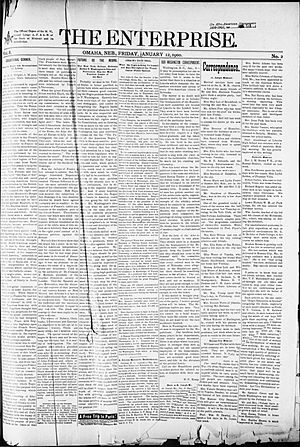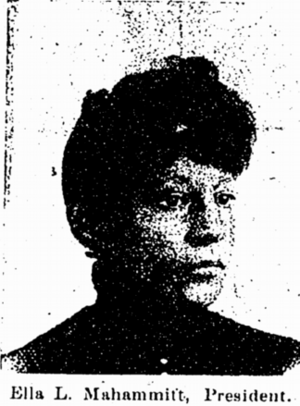Enterprise (Omaha) facts for kids

Cover of the January 12, 1900, issue
|
|
| Publisher | Mahammitt & Smith |
|---|---|
| City | Omaha, Nebraska |
| Country | United States |
| OCLC number | 10529510 |
The Enterprise was an important newspaper for African Americans in Omaha, Nebraska. It was published for many years, from 1893 to 1914.
At first, George F. Franklin was the editor. Later, Thomas P. Mahammitt took over and ran the paper for most of its life. The Enterprise was different from another Black newspaper in Omaha, the Afro-American Sentinel. It focused less on religion and culture. It also had careful views about war.
After the Enterprise stopped publishing, another newspaper called the Mission Monitor grew to take its place.
Contents
History of the Newspaper
The Enterprise newspaper was printed from January 1893 until 1914. For its first seven years, from 1893 to about 1900, George F. Franklin was its editor. After that, Thomas P. Mahammitt became the editor. This newspaper was also the official paper for the Nebraska State Afro-American League.
What Was in the Paper?
The Enterprise had many interesting sections. It included stories from other places and personal news. There were also church announcements. Regular writers included civil rights activist W. H. C. Stephenson and minister John Albert Williams.
Ella Mahammitt, who was Thomas Mahammitt's wife, also wrote a weekly column. She was a strong supporter of civil rights and women's rights. Her column focused on topics important to women.
The paper reported on unfair treatment and racism in Nebraska. It supported the ideas of Booker T. Washington about education and job training.
The Paper and Big Events
The Enterprise supported the Spanish–American War. However, some writers worried that helping in Cuba might bring American racial problems there.
During the 1898 Trans-Mississippi Exposition in Omaha, the Enterprise encouraged the local Black community. It wanted them to create exhibits for the big fair. At first, they supported having a separate "Negro building" at the fair. But later, the community decided against it.
Both Black-owned and white-owned businesses placed ads in the paper. These advertisements brought a lot of money to help the newspaper run.
The End of the Newspaper
The Enterprise stopped being published in 1914. John Albert Williams, who wrote columns for the Enterprise, felt it was important to have another Black newspaper in Nebraska. Because of this, he started publishing the Mission Monitor more widely.
How We Can Still Read It
In 1941, a group worked to save historical Black newspapers. They made copies of the Enterprise on microfilm. You can find issues from 1895 to 1897 at the Omaha Public Library. The paper is listed with the OCLC number 10529510.


